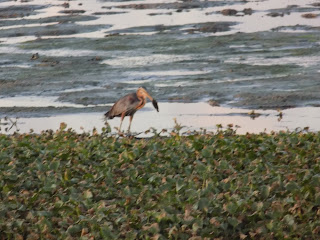Cinnamon Bittern செங்குருகு (Ixobrychus cinnamomeus) at backyard of Annakkili Amma Research Institute (Photo Credit: U Elaya Perumal)
Cinnamon Bittern செங்குருகு (Ixobrychus cinnamomeus)
This bird was observed since March 2021, but it was very rarely seen, that too while flying away. They stay inside the bushes, if we go near to bushes they fly away... the earlier observations were from Medavakkam Lake. During those time they simply fly away and escape, I was not able to notice its characters properly hence I could not identify. This bird is very new to me so I need to check all its characters to identify it because I have never seen it before. this was happening till May 2021.
In may 2021 that miracle happened this bittern straight away reached the bush in front of our home. that is the time I could see it properly. when I saw the bill (peak) of this bird I recognized as it is a bittern, later found it was
Cinnamon bittern. a couple of bitter was visiting our place to stay protected, which is the same place where
Moorhen was hatched their chicks. But now
White-Breasted Waterhen has occupied the place, hence after trying for two three days this bittern left that area.
Even though it was visiting nearby we could not take clear pictures because it was full of bushes, but on one day evening, we could observe a bittern in an open space. I was called by the
AARI admin to take pictures and immediately I went and clicked a lot of pictures. it was giving a nice pose. for the first and last time, it didn't fly away after seeing me. it was literally seeing me by turning its neck but didn't fly. our recent observation confirms that they stay at the backside of the AARI building, where birds like
Bronze-winged Jacana,
The Eurasian Moorhen,
White-breasted Waterhen,
Grey-headed Swamphen have bred. I hope this bittern couple also will breed over there, it is in the center of wetland, filled with two Palm trees, Typha, and some thorny trees, The bush is thicker and safer except for the issues with snakes.
Here are some pictures Cinnamon Bittern (செங்குருகு) for you to see...
Cinnamon Bittern செங்குருகு (Ixobrychus cinnamomeus) at the backyard of Annakkili Amma Research Institute (Photo Credit: Elaya Perumal)
Cinnamon Bittern செங்குருகு (Ixobrychus cinnamomeus) looking at me weirdly from the backyard of Annakkili Amma Research Institute (Photo Credit: Elaya Perumal)
யாரும் இல்லை; தானே கள்வன்;
தான் அது பொய்ப்பின், யான் எவன் செய்கோ?
தினை தாள் அன்ன சிறு பசுங் கால
ஒழுகு நீர் ஆரல் பார்க்கும்
குருகும் உண்டு, தான் மணந்த ஞான்றே.
கபிலர் (குறுந்தொகை 25)
In the above-mentioned Poem, the great poet Kabilar mentioned the characters of Bittern...
Thank you all...
Stay Home Stay Safe
Help Nature to Recover...

















